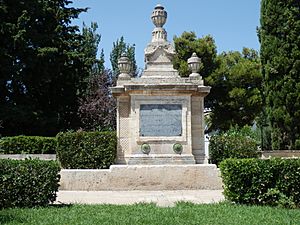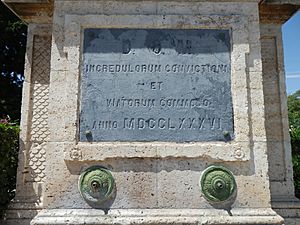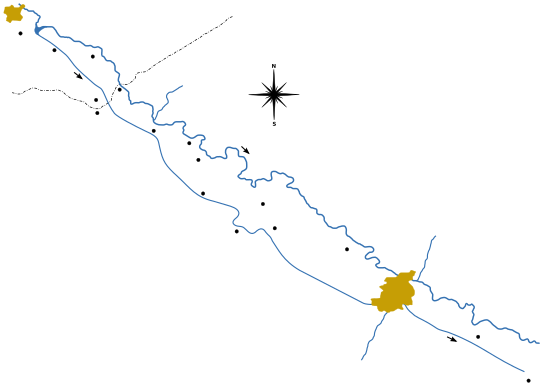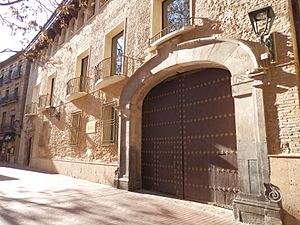Imperial Canal of Aragon facts for kids
Quick facts for kids Imperial Canal of Aragon |
|
|---|---|
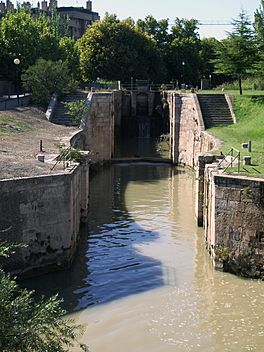 |
|
| Location | Spain |
| Coordinates | 42°01′35″N 1°33′37″W / 42.026264°N 1.560233°W |
| Type | Ebro Basin |
| Part of | Bocal de Fontellas, Navarre |
| Primary outflows | Fuentes de Ebro, Aragon |
| Max. length | 110 km (68 mi) |
The Imperial Canal of Aragon (in Spanish, Canal Imperial de Aragón) is a very important waterway in Spain. It's like a long, man-made river, about 110 kilometers (68 miles) long. People built it between 1776 and 1790. It stretches from Fontellas in Navarre to Fuentes de Ebro in Aragon.
The main reason for building this canal was to bring water from the Ebro River to farms around Zaragoza. This helped farmers grow more crops. It also created a way for people and goods to travel between Tudela and Zaragoza. This canal was one of the biggest water projects in Europe at that time.
Contents
How the Imperial Canal of Aragon Was Built
Why Was the Canal Needed?
Back in the 1700s, during a time called the Enlightenment, people in Spain wanted to build canals. They saw how canals helped countries like England and France. The idea was to connect the Ebro River to other big rivers and even to the Atlantic Ocean and the Mediterranean Sea.
People in Aragon also dreamed of having a direct way to send their farm products to the sea. This would help them sell their goods more easily. The Imperial Canal was a big part of this larger plan, even though only some parts of the whole project were finished.
Building the Canal: A Big Project
Building the Imperial Canal of Aragon was a huge challenge. Emperor Charles I first supported the idea in the 1500s. Work began in 1528, but it stopped for a long time.
In 1771, a special group called the Council of Castile decided to restart the project. They put Ramón Pignatelli in charge. He was a very important person who made sure the work got done.
The construction started again in 1776. The canal had three main goals:
- To provide water for irrigation (watering farms).
- To create energy (for mills).
- To be a way for people and goods to travel.
Ramón Pignatelli oversaw the building of the canal and many structures. These included the El Bocal weir, the large Acueducto del Jalón (an aqueduct over the Jalón River), and many bridges. He also built the Casablanca locks and mill and the Valdegurriana locks.
On August 15, 1790, the 110-kilometer (68-mile) Imperial Canal of Aragon was finally finished. This was a major achievement for Spain.
Important Structures of the Canal
What Are Locks and Why Are They Important?
The Imperial Canal of Aragon drops about 125 meters (410 feet) over its whole length. This means the water flows downhill. To make it possible for boats to travel both up and down the canal, engineers built special structures called locks. Locks are like water elevators that raise or lower boats from one water level to another.
Three main groups of locks were built on the canal near Zaragoza:
- Casablanca Locks: These locks are at kilometer 81. They helped control the water level before the canal crossed the Huerva River. They also served the port of Casablanca. Today, these locks are not used anymore.
- Valdegurriana Locks: At kilometer 89, you can find the four Valdegurriana locks. They lower the canal by 13 meters (43 feet). These locks are made of strong stone. They are also not used today.
- Torrecilla Road Locks: These three locks are at kilometer 91. They dropped the water level by 9.75 meters (32 feet). Sadly, these locks are now in ruins.
The Fountain of the Unbelievers
In 1782, the canal's water reached Zaragoza. This was a huge moment for the city. On October 14, 1784, the person who designed the canal, Ramón Pignatelli, arrived in Zaragoza by boat. People and leaders were very happy to see him.
The main construction work finished a couple of years later. On November 30, 1786, the Port of Casablanca opened. The next day, the Port of Torrero also opened. A few days after that, a special fountain was built in Zaragoza. It was ordered by Pignatelli himself. This fountain showed everyone that the canal's water had truly arrived in the city. Its inscription means: "To convince unbelievers and to bring rest to travelers. Year 1786."
How the Canal Changed Farming
The Imperial Canal of Aragon brought a big change to farming in the area. Ramón Pignatelli also led this change, which was called an agrarian reform. By bringing water to dry lands, the canal helped farmers grow more food. This meant people had more to eat and didn't have to worry as much about food shortages. It also allowed people to farm land that was once empty.
Pignatelli wanted to help poor farmers. He believed that the canal would allow them to buy land cheaply and grow crops. This would improve their lives. He thought that farmers should be favored over rich landowners.
This idea caused some arguments. Big landowners preferred to use their land for grazing cattle. They didn't want to change to farming. Pignatelli had to argue with powerful people and groups to make his plan work.
One of the canal's goals was to allow boats to travel. However, the canal was never extended past Zaragoza as planned. This meant it couldn't connect to the Ebro River and the sea as hoped.
Still, navigation on the canal began in 1789. It offered services for carrying goods and people. Boats were comfortable and cheap. People could travel from Zaragoza to El Bocal in one day.
However, things changed in the 1800s. The War of Independence stopped traffic for a while. Then, in 1861, a new railroad line was built. This railroad went right next to the canal. It was faster and easier to transport goods and people by train. Because of the railroad, the canal's use for navigation slowly stopped.
Map of the Canal
The Imperial Canal of Aragon is 110 kilometers (68 miles) long. It runs between Fontellas in Navarre and Fuentes de Ebro in Zaragoza.
The Canal Today
Since 1818, the main offices for the canal have been in a building called the Casa del Canal in Zaragoza. Today, the offices are at 1 Avenida de America in Zaragoza. This building holds important old documents and books about the canal.
The canal is still very important for irrigation. It provides water to farms in three main areas:
- Upper zone: Includes places like Ribaforada and Gallur.
- Middle zone: Includes areas like Boquiñeni and Alagón.
- Lower zone: Includes places like Garrapinillos and El Burgo de Ebro.
The canal is now managed by the Confederación Hidrográfica del Ebro. This is a government agency that takes care of water resources in the Ebro River basin.
Images for kids
See also
 In Spanish: Canal Imperial de Aragón para niños
In Spanish: Canal Imperial de Aragón para niños


